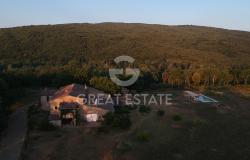Umbria
Umbria is considered as the "green heart" of Italy due to its central position and vast woodlands. Crossed by the Apennines, one-third of its territory is mountainous while the rest is covered with picturesque hills with olive groves and vineyards. The region is distinguished for many aspects ranging from literature to gastronomy, for its richness in history, culture and many medieval hill-towns and monasteries.
Perugia is the capital of Umbria and contains some of the most beautiful art and architecture in the province with a score of beautiful churches and an important Etruscan museum. The National Gallery of Umbria located in the ancient and beautifully restored town hall along the Corso Vanucci has the best collection of Umbrian painting in Italy, including important works by Gentile da Fabiano, Perugino, and Piero della Francesca.
Among the other cities are Assisi, Gubbio, Orvieto, Spoleto. Among this Assisi is the most famous for Giotto fresco cycle about the life of Saint Francis and frescoes by Cimabue, Simone Martini and others in the church of Saint Francis.
The land is very fertile and the main produce are cereals, tobacco, sugar-beet, sunflowers, vineyards; Other flourishing sectors are food products, textiles, clothing and the graphics and publishing industry alongside the more traditional sectors of iron and steel, machinery, chemicals and wood. Industry is especially linked to the electrical power plants and steel mills in the province of Terni. Deruta, Gubbio and Orvieto are cities renown for the ceramic production
For food lovers, among many other specialties, there are Castelluccio lentils, a highly prized variety, the famous pork and salami products known as "norcineria" and the black truffle, for which Umbria is one of the first producers in Europe.
Umbria has numerous curiosities among its vines and wines which rarely leave the region, such as the Vin Santo, pressed from semidried Grechetto or Malvasia grapes, which is usually sweet. Red wine from the area is now covered by the DOCs of Rosso Orvietano and Lago di Corbara. The most prestigious Umbrian wines are the red Torgiano Rosso riserva and Sagrantino, an ancient variety grown only around the hill town of Montefalco, which have special status as DOCG. Orvieto, instead, is one of Italy's best-selling DOC whites with a strong following abroad.
Le Marche
Le Marche are an enchanting corner of Italy with a varied landscape combining hill countryside with a long coastline extending along the Adriatic Sea for about 180 km. It is characterized in the hinterland by fine medieval boroughs, whereas the coastline has low waters and fine sandy beaches, apart from one high, rocky cliff at Monte Conero.
Ancona is the regional capital and its a natural port, dating back to the 5th century BC, when it was founded by Greek exiles from Siracusa in Sicily. Together with Pesaro, which is the birthplace of composer Gioacchino Rossini, its one of the pivotal centres of the coastline. In the hinterland the medieval highlights of the region are the cities of Ascoli Piceno and Urbino.
The region is full of natural beauty and has two national parks (Monti Sibillini and Gran Sasso and Monti della Laga) and four regional parks (Monte Conero, Sasso Simone and Simoncello, Monte San Bartolo, Gola della Rossa and Gola di Frasassi). The Grotte di Frasassi are caves dating back thousands of years and with their small lakes, stalactites and gigantic stalagmites are among the largest accessible caverns in Europe.
The region's traditional industries are papermaking, shipbuilding, shoe manufacturing, food, furniture, musical instruments and synthesizers and apparel. Among the typical local products are: ceramics, terracotta, copper, rugs, wooden pipes, hats, musical instruments, toys, leather goods, furniture, gold, paper, straw, wicker and travertine.
The many delicacies of Le Marche include ciauscolo salami, cheese from Talamello matured in caves, prized truffles from Acqualagna, Sant'Angelo in Vado and Sant'Agata Feltria, casciotta cheese from Urbino, ham from Carpegna and salami from Fabriano.
Among the local dishes you have Ancona-style dried cod, "vincisgrassi" (lasagne made with chicken livers and truffles), Olive all’Ascolana (stuffed, fried olives from Ascoli Piceno), and "brodetto" (fish stew).
The region has 12 DOC wines, the main regional white is the excellent Verdicchio, and other whites are the Bianchello del Metauro and the Bianco dei Colli Maceratesi. As for the reds Rosso Conero and the Rosso Piceno.












